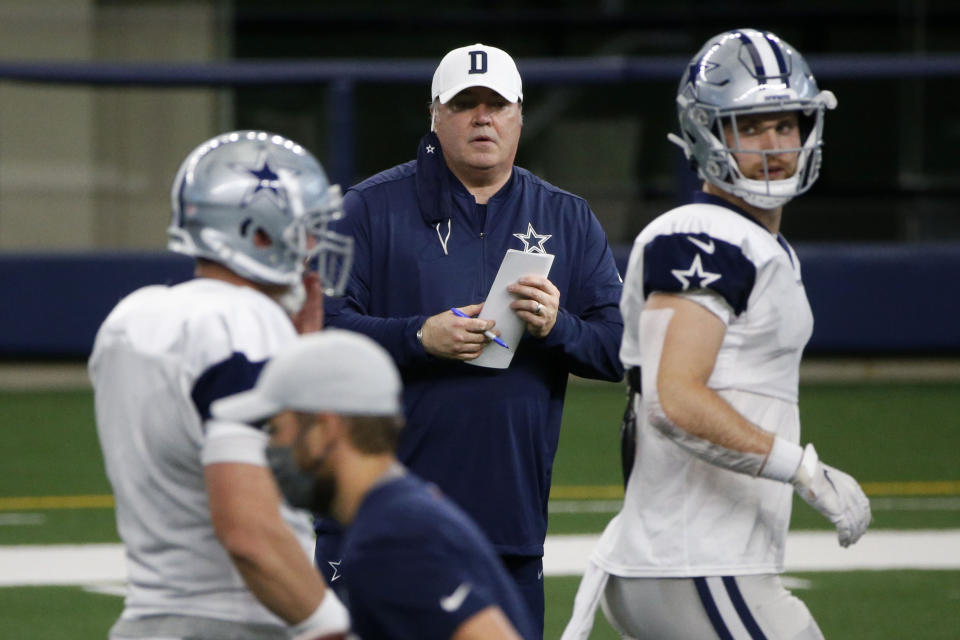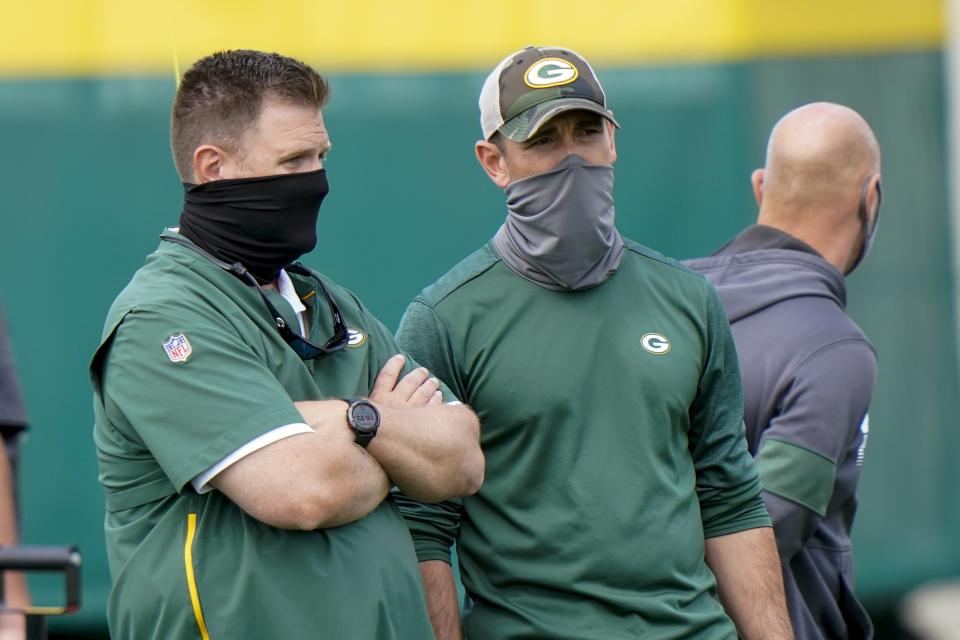Cowboys may look like NFL’s most paranoid team this preseason. But they have company
When the local television feed flickered on for the Dallas Cowboys’ annual preseason scrimmage on Sunday night, it was instantly apparent that something different was about to happen.
Dak Prescott? No name or number.
Ezekiel Elliott? Nothing identifiable.
The much anticipated new era “Triplets” at wideout? Blank jerseys all around.
This wasn’t a field of football players. It was a chess board set up between two opposing jersey colors, with key players distinguishable only by their shapes, sizes and positions on the field. Not that viewers actually saw any of the positions on the field, that is. The Cowboys stomped most of that out, too, focusing the broadcast on a stream of sideline glamour shots and angles tight enough to asphyxiate eyeballs.

It felt like Dallas was either reaching toward the depths of paranoia or the peaks of intelligence. Maybe it was a little bit of both. At least one thing was certain: This was a very on-brand moment for the Cowboys this summer, not to mention the NFL as a whole, which has seemingly spent the past month turning training camp practices into a series of CIA company picnics.
Sure, you could see players. But for essentially every NFL franchise, you weren’t allowed to describe much of what they were doing, where they might be fitting in a scheme or whether they were in starting units. Basically, the three least popular visitors to NFL training camps this preseason were COVID-19, Twitter and cellphone cameras.
That’s how we arrived to this month, with NFL teams knowing very little about what anyone else is doing. Pretty much every franchise in the league came armed with two pieces of PPE this past month: A mask to protect players from the virus, and a gag order to protect teams from giving away any tactical information about their players.
“This is such a unique season on so many fronts,” Cowboys coach Mike McCarthy said after the Cowboys’ featureless scrimmage. “I can’t tell you the number of conversations you have about competitive advantage and disadvantage — and frankly, with the fact that we were televising the practice here, we would be exposing our younger players to an evaluation process that the other teams really are not exposing their team to. That was the reason behind going with the [blank] white and blue shirts.”
It was at least mildly amusing, if only because it came off as a typical reminder of how paranoid NFL teams can be about giving away an edge. But McCarthy’s rationale also wasn’t wrong. He’s well aware that teams across the league have essentially decimated the amount of information that can escape from franchises this offseason. A trend that exists solely because of the lack of preseason games that typically stand as the best tool teams have to evaluate players, schemes and potential waiver wire pickups.
For the first time that anyone can remember in the modern NFL era, the league basically had a month of closed practices where very little was showcased to anyone outside its buildings. What developed inside that landscape was consistent, if not efficiently oppressive. For example, most teams this offseason barred reporters from referring to groups of “starting” players. They also clamped down on descriptions of which players were practicing in specific packages, from the exotic designs to the vanilla base looks of nickel and dime personnel.
And teams weren’t kidding about the limitations, either. Dallas had a flare-up in the middle of camp practices when one content producer tweeted out some details of what happened on the field. The Buffalo Bills reportedly went one big step further, allegedly suspending a team-employed multimedia reporter after he produced content that explored what he had witnessed in the previous day’s practice. The Seattle Seahawks, who barred reporters from talking about anything beyond the first 10 minutes of practices, prohibited cameras from the team scrimmage after warmups. The Las Vegas Raiders told players to be careful what they reveal about the performance of teammates in virtual interviews.
Some of these mandates started on Day 1. Others were adopted mid-stream by some franchises — after they realized that other teams were clamping down on even the tiniest shreds of information being released.
As Green Bay Packers general manager Brian Gutekunst said after changing the team’s media policies on the fly, “As we got into the first three days [of practice], and seen the landscape of what other teams were doing, and just the information we were gathering … without 8,000 people at practice and four preseason games, I thought we were at a disadvantage [by allowing information to be reported], and I wanted to equal the playing field.”

That was the same sentiment echoed by San Francisco 49ers coach Kyle Shanahan, after he altered the team’s media policy into a more strict set of “no reporting” rules.
“No one gets any tape, so we’re not going to see anything on [the Arizona Cardinals] until we get out there for the first play in the first quarter [of Week 1],” Shanahan said “And the same thing with us.”
Of course, that’s not the only reason teams are choking off information. Every franchise will see its practice squads swell from 10 to 16 this season. That means six additional slots to stash players the team believes are worthy of being on the regular-season roster but simply can’t make the numbers work. Making that stash work is more achievable than ever this year because teams don’t have the tools they need to see if other players on opposing franchises catch their eye.
“Not having the [preseason] games definitely takes away a tool that you would use to see if there is a younger player you don’t know about who might help you,” an AFC general manager said. “But that goes both ways because it might be able to help us keep some guys, too. In that sense, the paranoia is probably a little overblown — because honestly, we’re all kind of in the same situation. …
“It’s really hard to know anything about a player on another team without seeing them on tape, playing in some game speed. We’re kind of protecting information on guys that another team isn’t really going to take a chance on, because none of us can really evaluate them anyway. Who really knows what these guys look like in 14 padded practices?”
That doesn’t mean teams aren’t trying to glean anything they can. Multiple NFL clubs have assigned at least one person to monitor anything that is coming out on social media in terms of practice snippets or nuggets of information from opposing teams. And all of them are well aware of the other franchises that are carrying monster draft classes and will likely have to cut some of their draft picks. The Minnesota Vikings’ 15-man rookie class, for example, will certainly see some cuts that may be picked up by other teams — sheerly based on draft evaluations. Same for the Jacksonville Jaguars and their 12-man class and a handful of others with double-digit groups.
And that doesn’t account for some solid veterans who could get cut, which is a very hot topic for almost every NFL team right now. A point that was illustrated Wednesday morning, when some teams were putting feelers out about Minnesota Vikings offensive tackle Riley Reiff, essentially hoping that an impasse on a contract structure would suddenly land him on the waiver wire. It didn’t, as Reiff re-worked his deal with the Vikings. But his was the kind of situation teams wanted to be prepared for as they consider their own cuts and whether a last-minute pickup could unexpectedly bolster the roster in the next week.
“Reiff would have been a good one to come loose,” another AFC general manager said. “There would have been some interest there, definitely. And he’s probably a good example of what we’re missing [without the preseason games]. They must feel pretty good about some of their other guys to even consider letting him go — and that’s a numbers game you can sometimes see on tape. When you see some younger, cheaper guys really pop a bit in some [preseason] games, there’s a chance that someone ahead of them on a depth chart suddenly becomes a little more expendable. Then you pick up the phone to see if that’s the case. We’ve lost that scouting part of it, definitely.”
Time will tell how it all parlays into the next week, as NFL teams cut down rosters and start making a flurry of calls to see if another franchise might be interested in a player nobody expected to get cut. Chances are there are some surprises coming, making paranoia and secrecy look more like smart diligence.
More from Yahoo Sports:

 Yahoo Sports
Yahoo Sports 